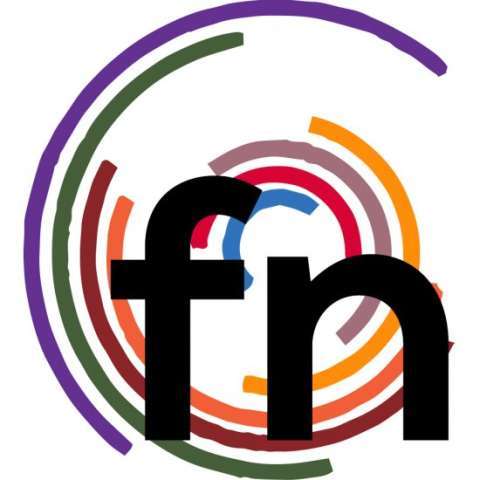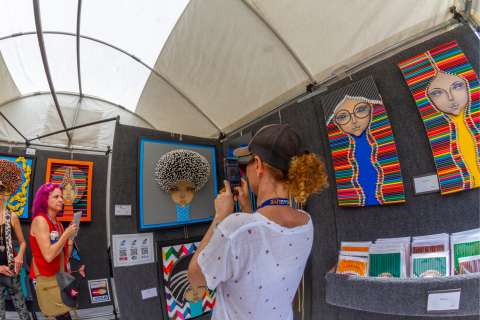Selling your art is a unique and deeply personal experience. The channels through which you market and sell your pieces can shape not only your profit but your entire career. In the dynamic world of art, two prominent methods stand out: selling your art online vs. at art fairs. Both have their merits and drawbacks, and your choice depends on your particular needs and circumstances. Here's everything you need to know about both options.
The Artist's Palette: Crafting a Career Through Sales
Being an artist is not just about creating; it's about connecting with your audience, sparking emotions, and turning a passion into a livelihood. With the rise of digital platforms, artists have more options than ever to showcase their talent. But art fairs have a timeless allure that can't be overlooked.
As we delve into selling your art online vs. at art fairs, we'll explore the unique facets of each, subtly highlighting the art fair's irreplaceable charm.
The Virtual Gallery: Selling Art Online
Selling art online is like opening your personal gallery to the entire world. With just a click, people from various cultures can view and purchase your work. Let's explore what this avenue has to offer.
Pro: Convenience and Reach
Selling art online offers the advantage of convenience and a global reach. Your virtual gallery is open 24/7, attracting art enthusiasts worldwide. Websites and social media platforms can spotlight your talent to a wider audience.
Pro: Lower Overhead Costs
Operating online typically means fewer overhead expenses. There's no need to rent physical space or employ sales staff, making this a more cost-efficient option.
Pro: Analytics and Targeting
Online platforms provide powerful tools to analyze your audience's behavior and preferences. You can tailor your marketing efforts and target specific demographics, enhancing your chances of making a sale.
Con: Lack of Physical Connection
Despite all the convenience and global reach, online selling lacks the tactile experience many art buyers crave. The inability to see and touch the art in person can be a significant barrier for some potential buyers.
Con: Competition and Originality
Also, the competition is fierce. To stand out, you must offer something unique, spend time on marketing, and engage with your audience. Also, potential buyers may hesitate if they can't experience the artwork in person.
Con: Potential for Impersonation and Fraud
Selling online comes with risks of impersonation and fraud. Ensuring a secure payment process and protecting your artistic identity can be challenging, even with all the tech advantages we have at our disposal nowadays.
The Traditional Touch: Art Fairs
Art fairs have an unmatched charm, allowing art lovers and creators to meet face-to-face. These physical venues are more than just markets; they are celebratory gatherings of creativity and talent. Here are the dynamics to consider.
Pro: Personal Connections and Live Interaction
Art fairs provide a distinctive platform for artists, allowing them to engage personally with art enthusiasts, collectors, and potential buyers. Face-to-face interaction creates a unique connection that online platforms can't replicate. Whether sharing your inspiration behind a piece, answering specific questions, or demonstrating your techniques, the live dialogue fosters a deeper connection with your audience.
Pro: Exclusivity and Reputation Building
Being part of well-known art fairs not only enhances your reputation but also provides a sense of exclusivity to your work. These curated events often attract serious buyers, art collectors, and critics. By aligning yourself with prestigious art fairs, you can position your work within a context of quality and significance, leading to higher recognition and, potentially, better sales. This can truly help you stand out as an artist at an art fair.
Pro: Immediate Feedback and Adaptation
One of the remarkable benefits of selling at art fairs is the opportunity to receive real-time feedback. Observing how people interact with your art and listening to their comments and questions allows you to understand your audience's perspective. This direct insight can inform future creations, help you adapt your presentation, and refine your sales approach on the spot, creating a dynamic and responsive selling environment.
Pro: Potential Collaboration and Networking Opportunities
Art fairs are bustling hubs of creativity, bringing together artists, gallery owners, collectors, and art enthusiasts from various backgrounds. Participating in these events opens doors to collaboration and networking opportunities that might not be readily available online. By mingling with fellow artists, striking up conversations with gallery owners, or impressing a wandering critic, you can forge valuable connections that could lead to exciting future collaborations or exhibitions.
Con: Dependence on External Factors
Art fairs can be affected by unforeseen circumstances like weather conditions, changes in regulations, or other external factors. These uncertainties can impact foot traffic and overall success, making this approach potentially riskier.
Con: Expenses and Logistics
But art fairs can be costly. Renting a booth, travel expenses, and the time and energy required to pack for transport can add up. Yet, if you do it the right way, the personal connection and exclusivity of a live showcase may well be worth the cost.
Con: Limited Audience Reach
Art fairs often have a limited geographical reach. Unlike online sales, these events might not attract a global audience, which might limit exposure to potential buyers. However, this shouldn't discourage you from promoting your art at fairs and festivals, as the crowd that does attend these events is truly engaged and interested in your work.
Blending the Brushstrokes: Combining Both Worlds
Some artists find success in blending both methods. They use online platforms to promote their presence at art fairs and leverage the personal connections made at fairs to grow their online following. This approach maximizes exposure and can be a winning strategy for many.
A Final Brushstroke: Drawing Your Own Path
Selling your art online vs. at art fairs is a decision that shapes your artistic journey. Online sales offer broad reach and convenience, while art fairs offer the unparalleled opportunity to connect personally with your audience. Consider your goals, budget, and personal preferences as you craft your unique path in the art world. Embrace the method that resonates with you, and let your art shine.



